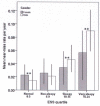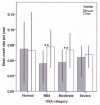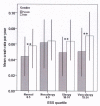Excessive daytime sleepiness increases the risk of motor vehicle crash in obstructive sleep apnea
- PMID: 24127145
- PMCID: PMC3778172
- DOI: 10.5664/jcsm.3072
Excessive daytime sleepiness increases the risk of motor vehicle crash in obstructive sleep apnea
Abstract
Study objectives: (1) To describe the incidence rate of motor vehicle crashes (MVCs) in patients with obstructive sleep apnea (OSA); and (2) to investigate MVC risk factors in OSA patients.
Methods: A retrospective case-series observational study was conducted using data from the West Australian Sleep Health Study at a tertiary hospital-based sleep clinic. Participants were patients (N = 2,673) referred for assessment of suspected sleep disordered breathing. Questionnaire data were collected including age, sex, years of driving, near-misses and MVCs, sleepiness, and consumption of alcohol and caffeinated drinks. Overnight laboratory-based polysomnography was performed using standard methodology.(1) Poisson univariate and negative binomial multivariable regression models were used to investigate associations between risk factors and MVC and near-miss risk in patients with untreated OSA.
Results: In patients with untreated OSA, the crash rate was 0.06 MVC/person-year compared with the general community crash rate of 0.02 MVC/person-year. The rate ratio comparing very sleepy men with normal men was 4.68 (95% CI 3.07, 7.14) for near-misses and 1.27 (95% CI 1.00, 1.61) for crashes, after adjusting for confounders. In women there was a significant association with sleepiness score (p = 0.02) but no dose effect across quartiles.
Conclusions: Untreated OSA is associated with an increased risk of near-misses in men and women and an increased risk of MVCs in very sleepy men. There is a strong association between excessive daytime sleepiness and increased report of near-misses. Our data support the observation that it is those patients with increased sleepiness regardless of OSA severity who are most at risk.
Keywords: Motor vehicle crashes; gender; near-misses; obstructive sleep apnea; severity; sleepiness.
Figures




References
-
- American Academy of Sleep Medicine Task Force, Sleep-related breathing disorders in adults: recommendations for syndrome definition and measurement techniques in clinical research. The Report of an American Academy of Sleep Medicine Task Force. Sleep. 1999;22:667–89. - PubMed
-
- Teran-Santos J, Jimenez-Gomez A, Cordero-Guevara J. The association between sleep apnea and the risk of traffic accidents. Cooperative Group Burgos-Santander. N Engl J Med. 1999;340:847–51. - PubMed
-
- Sagaspe P, Taillard J, Chaumet G, et al. Maintenance of wakefulness test as a predictor of driving performance in patients with untreated obstructive sleep apnea. Sleep. 2007;30:327–30. - PubMed
-
- Mulgrew AT, Nasvadi G, Butt A, et al. Risk and severity of motor vehicle crashes in patients with obstructive sleep apnoea/hypopnoea. Thorax. 2008;63:536–41. - PubMed
Publication types
MeSH terms
LinkOut - more resources
Full Text Sources
Other Literature Sources

